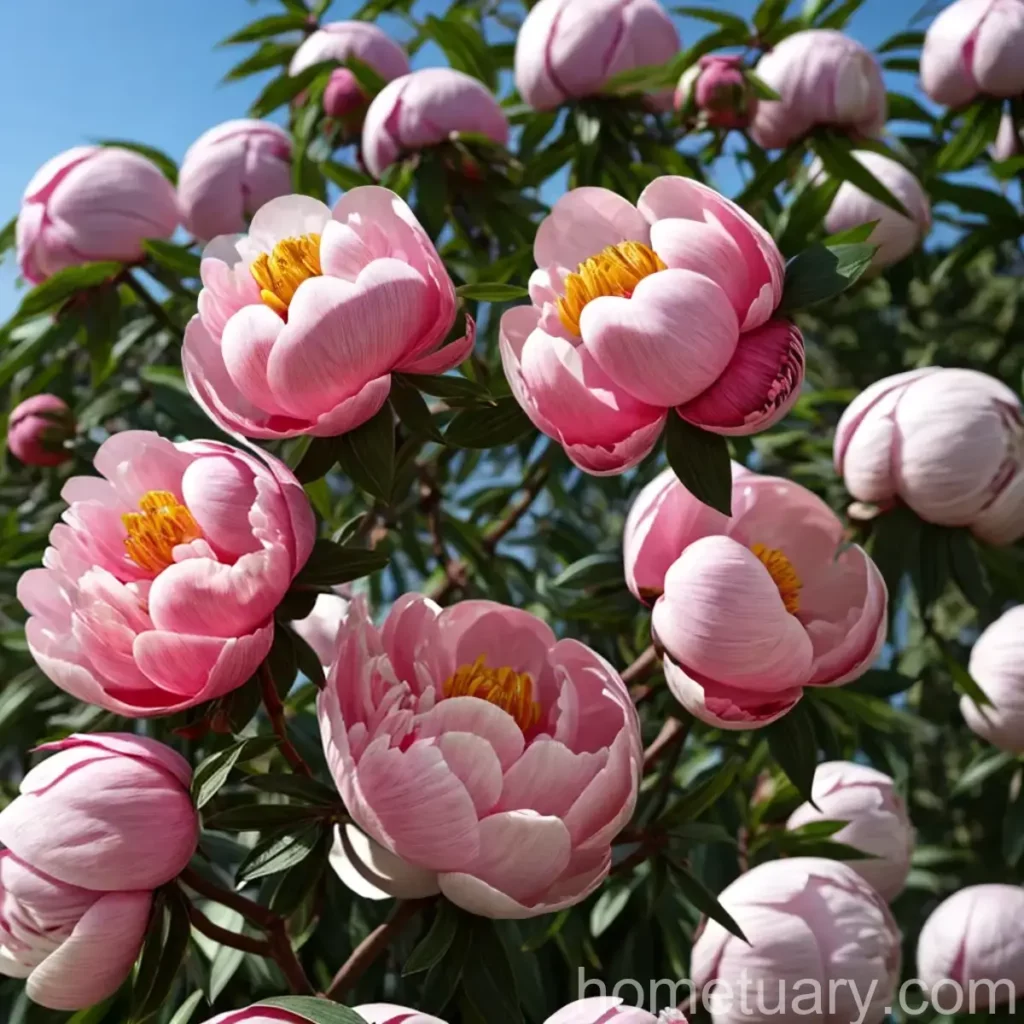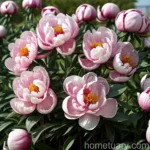Plant Scientist’s Guide to Tree Peony (Paeonia ‘Themis’)
In this comprehensive guide, we will delve into the world of tree peonies, specifically focusing on the Paeonia ‘Themis’ variety. With a keen eye on caring for and cultivating these beautiful plants, this guide aims to provide valuable insights for both beginners and seasoned gardeners. From understanding the key characteristics of tree peonies to mastering their pruning techniques, we will cover it all. So, let’s begin our journey into the captivating realm of tree peonies.
What is a Tree Peony?
Tree peonies, scientifically known as Paeonia suffruticosa, are deciduous shrubs that belong to the Paeoniaceae family. Contrary to their name, these plants are not true trees but are termed as such due to their woody stems. Originating from China, tree peonies have been cultivated and admired for centuries for their exquisite and stunning blooms.
Tree peonies are known for their large, showy flowers that come in a wide array of colors, including delicate pastels and vibrant hues. Their flowers exude an alluring fragrance, adding to their overall appeal. Additionally, these plants possess attractive, deeply lobed foliage, making them a striking addition to any garden or landscape.
Key Takeaways – Tree Peony (Paeonia ‘Themis’)
Before we delve into the specific aspects of tree peony (Paeonia ‘Themis’) care, let’s highlight some key takeaways about this stunning plant:
- Scientific Name: Paeonia ‘Themis’
- Type: Deciduous shrub
- Characteristics: Large, showy flowers, attractive foliage
- Origin: Cultivated variety
- Care Level: Moderate
- Ideal Growing Conditions: Well-draining soil, ample sunlight, and regular watering
- Uses: Ornamental purposes, landscaping, and cut flower arrangements
Now that we have an overview of tree peonies, let’s dive deeper into their specific care requirements and characteristics.
Culture
Cultivating tree peonies, especially the Paeonia ‘Themis’ variety, involves understanding their specific cultural needs. Let’s explore these aspects in detail:
Uses
Tree peonies, including the Paeonia ‘Themis’ variety, serve various purposes in horticulture and landscaping. Some of their common uses include:
- Ornamental Purposes: The large, dazzling blooms of tree peonies make them an exquisite addition to gardens and landscapes, adding a touch of elegance and charm.
- Cut Flower Arrangements: The flowers of tree peonies are often used in floral arrangements, bouquets, and as decorative elements due to their alluring beauty and fragrance.
Water
Proper watering is crucial for the healthy growth and blooming of tree peonies. These plants generally require consistent moisture without waterlogging. Here are some essential watering techniques for tree peonies:
- Regular Watering: Tree peonies benefit from regular watering, especially during dry periods or when grown in containers. Aim to keep the soil evenly moist but not waterlogged to prevent root rot.
- Deep Watering: When watering, ensure that the water penetrates deeply into the soil to encourage strong root growth and resilience to drought.
Sunlight
Tree peonies, including the Paeonia ‘Themis’ variety, thrive in ample sunlight. However, they also appreciate some protection from intense midday sun. Here’s a rundown of their sunlight requirements:
- Full Sun to Partial Shade: Tree peonies prefer locations with full morning sun and partial shade in the afternoon to shield them from the scorching heat.
- Optimal Light Exposure: Providing the right balance of sunlight ensures robust growth and profuse flowering while preventing sun damage to their delicate blooms and foliage.
Fertilizer
Fertilization plays a significant role in promoting the overall health and blooming capacity of tree peonies. When it comes to the Paeonia ‘Themis’ variety, the right fertilization approach is essential. Here’s what you need to know:
- Balanced Fertilizer: Use a slow-release, balanced fertilizer to supply essential nutrients to tree peonies without the risk of over-fertilization, which can lead to excessive foliage growth at the expense of flowers.
- Application Timing: Apply fertilizer in early spring before new growth emerges, ensuring that the plant has access to vital nutrients during its active growing season.
Soil
The soil composition greatly impacts the growth and vitality of tree peonies. Understanding the ideal soil preferences of the Paeonia ‘Themis’ variety is crucial. Here are the soil considerations to keep in mind:
- Well-Draining Soil: Tree peonies thrive in well-draining, fertile soil that retains moisture without becoming waterlogged. Amending heavy clay or sandy soil with organic matter enhances the soil structure and fertility.
- pH Level: Preferably, the soil should have a slightly acidic to neutral pH, ranging from 6.5 to 7.0, to ensure optimal nutrient uptake by the plants.
Pruning
Proper pruning is vital for maintaining the shape, health, and blooming performance of tree peonies. When it comes to the Paeonia ‘Themis’ variety, specific pruning techniques can help maximize its ornamental appeal. Here’s a guide to pruning tree peonies:
- Seasonal Pruning: Prune tree peonies in late autumn or early winter when they are dormant. Remove any dead or damaged wood, as well as crossing branches to enhance air circulation within the plant.
- Trimming Faded Blooms: After the flowering season, deadhead spent blooms to encourage the plant to redirect its energy into producing new growth and flower buds for the following season.
Propagation
Propagating tree peonies, including the Paeonia ‘Themis’ variety, allows for the expansion of their presence in a garden or landscape. Understanding the specific propagation methods is essential. Here’s an overview:
- Division: Propagate tree peonies through division, preferably in early autumn, by carefully dividing the plant’s root ball into smaller sections, each containing viable roots and stems.
- Root Cuttings: Root cuttings can also be used for propagation, where healthy root segments are cut and planted in a suitable growing medium to develop into new tree peony plants.
Container Popularity
Tree peonies, including the Paeonia ‘Themis’ variety, are well-suited for container cultivation, allowing them to be grown in various settings. Here’s how to ensure their success in containers:
- Container Selection: Choose a large, sturdy container with adequate drainage holes to accommodate the expansive root system of tree peonies and prevent waterlogging.
- Growing Medium: Use a well-draining, nutrient-rich growing medium, and consider adding organic matter or perlite for improved drainage and aeration.
Common Diseases
Tree peonies, like many plants, are susceptible to certain diseases that can affect their overall health and vitality. Understanding these common diseases and their management is crucial for maintaining robust tree peonies, particularly the Paeonia ‘Themis’ variety. Let’s take a look at some prevalent diseases and their diagnosis:
Disease Diagnosis
- Botrytis Blight: Also known as gray mold, botrytis blight affects tree peonies, causing the development of grayish mold on the plant’s buds, stems, and flowers. Proper airflow, avoiding overhead watering, and pruning to improve air circulation can help prevent this fungal disease.
- Powdery Mildew: Powdery mildew appears as a powdery white coating on the foliage of tree peonies, compromising their overall aesthetic appeal. Adequate spacing, proper air circulation, and applying fungicidal sprays as a preventive measure can manage this disease effectively.
Common Pests
In addition to diseases, tree peonies are also prone to specific pests that can impact their growth and flowering. Recognizing these common pests and implementing suitable control measures is essential for maintaining healthy tree peonies, including the Paeonia ‘Themis’ variety. Let’s explore some prevalent pests:
Botanist’s Tips
To ensure the thriving of the Paeonia ‘Themis’ variety and to maintain healthy tree peonies, here are key botanist’s tips to consider:
- Regular Monitoring: Routinely inspect tree peonies for signs of pests, diseases, or nutrient deficiencies, enabling prompt intervention and management.
- Water Management: Practice careful watering to maintain adequate moisture levels without leading to waterlogging, as both overwatering and underwatering can negatively impact tree peonies.
Fun Facts
Before concluding this comprehensive guide, let’s delight in some fascinating fun facts about tree peonies:
- Tree peonies have been cultivated in China for over 1,500 years and are highly revered in traditional Chinese culture for their beauty and symbolism of prosperity and good fortune.
- The blooms of tree peonies can reach remarkable sizes, often exceeding 10 inches in diameter, and come in diverse colors, including shades of pink, red, white, and yellow.
Links to External Resources
To further enrich your knowledge and understanding of tree peonies, explore the following external resources:
-
American Peony Society: The American Peony Society offers a wealth of information on cultivating and appreciating various peony varieties, including tree peonies.
-
Royal Horticultural Society: The Royal Horticultural Society provides insights into the cultivation, care, and identification of tree peonies and other ornamental plants.
-
Fine Gardening: Fine Gardening presents articles and guides on ornamental plant care, including in-depth features on tree peonies.
In conclusion, the allure of tree peonies, particularly the Paeonia ‘Themis’ variety, extends from their striking blooms to their overall cultural significance. By understanding and implementing the right cultural practices, from watering and fertilization to disease management and pruning, you can foster the optimal growth and visual splendor of tree peonies in your garden or landscape. Embrace the timeless elegance of tree peonies and experience the joy of cultivating these captivating plants.
Remember to cherish the beauty and resilience of tree peonies while relishing their symbolic significance and ornamental appeal. Happy gardening!















